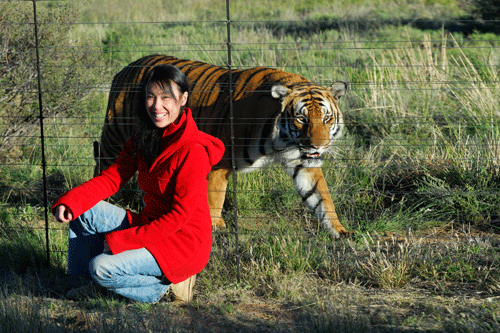An interview with Quan Li, founder of China Tiger Revival
An interview with Quan Li, founder of China Tiger Revival
对话“拯救中国虎国际基金会”创始人全莉
Pioneer Porfolio: Quan Li
Profession: founder of China Tiger Revival
Nationality: Belgian
Beijing born and bred, Quan Li worked in fashion in Italy prior to founding the China Tiger Revival Charity. In 2002, Quan established the Laohu Valley Reserve as a platform for the re-wilding of zoo-born South China tigers (Panthera tigris amoyensis) and biodiversity conservation.
Could you briefly introduce the China Tiger Revival and the Laohu Valley Reserve (LVR) in South Africa? What was your inspiration?
In October 2000, I launched China Tiger Revival (formerly Save China’s Tigers) in the Chinese embassy in London in the UK. The ambitious project aims to reverse the fate of the Chinese tigers by breeding them, helping them regain their natural hunting abilities and reintroducing them back into China’s wild.
Laohu Valley Reserve is located near the small town of Philippolis, Free State in South Africa, with an area of 33,000 hectares. It stretches right over Orange River with 1/3 of the area in Northern Cape and the other 2/3 in Free State. The unique reserve is made up of 17 chunks of defunct sheep farms.
I was born in the Year of Tiger and have always loved cats, especially the tiger. I’ve thought that conservation is the coolest thing ever since I visited the South Luwanga National Park in Zambia. I was deeply touched by the beautiful animals living freely.
When you were interviewed by the Xinhua News Agency, they mentioned that, in the beginning, the first two tigers—Cathay and Hope—were afraid of live chickens before they were rehabilitated. On July 25, 2004, they caught their first ever bushbuck and ate it. Are there any ot her interesting success stories ?
Well, I would like to share the story of Tiger Woods and Madonna. At the beginning of November 2004, Tiger Woods and Madonna arrived aged eight and seven months respectively.These cubs flew directly from Beijing via Hong Kong to Johannesburg and were again flown to Laohu Valley by the Bateleurs. The cubs were housed in a 0.2 hectare quarantine camp for the first month of their stay at LVR.
During this time, they were fed meat from the butchery, but within the first week of their arrival they were given hare carcasses. Both cubs devoured the hares completely, including the skin and bones. By the end of the quarantine period, they also got their first large carcass—a springbok. In contrast to Hope and Cathay, Tiger Woods immediately knew that this was food, and he wrestled it out of the hands of the staff at LVR. It still took him and Madonna quite some time to learn how to efficiently open a carcass, but by the third carcass, they were doing it like pros.
At the end of January 2005, Tiger Woods and Madonna moved from their small enclosure into a 4 hectare camp. Here, for the first time, they encountered live prey in the form of guinea fowl. At first, both cubs were rather clumsy in hunting the birds, but—after the third encounter—they were proficient in hunting and eating prey.
In April 2005, Madonna and Tiger Woods were again “upgraded” to a larger enclosure, this time to a 9 hectare camp. This enclosure also has a river running through it, and the cubs could be seen playing in the running water.
At the same time, blesbucks (a type of antelope) were also introduced into this camp. For the first two weeks, both cubs simply chased the blesbucks around, thinking it was some kind of game. And then it happened; they managed to kill one of the blesbucks and the penny dropped! This was food! What made this a remarkable achievement was that these two tigers succeeded in hunting for themselves a full year earlier than Cathay and Hope.
In 2006, they were released into the 40-hectare camp. What was very interesting to observe was that Tiger Woods would be the one stalking and chasing the blesbucks while Madonna lay in wait. As he chased the blesbucks past Madonna, she would leap up and attempt to catch them—but with little success. When Tiger Woods did bring down a blesbuck, it was often Madonna who gave the final bite to the neck while Tiger Woods held it in place.

Quan Li poses with her beloved Tiger Woods
Other than the tigers, does China Tiger Revival have any ot her conservation projects in China?
We made the South China tigers our current focus, as they are the most endangered subspecies of tiger and most ignored by the conservation world. We are, of course, championing causes for all tigers (four subspecies found in China) and big wild cats and hope to give our attention to them in due course. The tiger is at the top of the food chain. Saving the tiger would also save other animals in the chain by protecting the tigers’ habitat. Setting up a pilot reserve in areas where wild tigers might still exist will also help to protect bears, leopards, wild boars, antelopes and wild goats.
Can Chinese tigers even adapt to South Africa? Couldn’t they adapt just as well in China?
Having lived most of their life in small cages in zoos, these tigers need some time to adapt to the natural environment in South Africa. Cathay, Hope, Tiger Woods and Madonna have proved to us that once they are used to the nature there, it will be much easier for them to adapt to other environments—China or abroad. The tiger is very adaptable. From Siberia to Sumatra, it appeared almost everywhere in Asia, before humans threatened their very existence. Now, tigers live in zoos all over the world. Unlike pandas, tigers usually do not get air-conditioned cages or any other special treatment. So, we have every reason to believe that the Chinese tiger can adapt just as well to South Africa as they would the wild in China.
When can the tigers come back to China? Is there a time schedule?
Rewilding and reintroduction is a gradual process. When the cubs grow up, it will be the time to reintroduce second-generation tigers back into China. The State Forestry Administration of China is working with various levels of government authorities in an effort to reintroduce the first ones in China in 2013 or 2014. We plan to initially send four or five tigers back to test the adaptation processes. Not all the tigers will go back home at once; it depends on the development and construction of the pilot reserve in China as well as the success of the tigers’ reintroduction in China. As there is no reference for the reintroduction project, we have to be very careful.
Do you have any tips on how humans and nature can better live to gether?
I believe every human, in every country and climate, should find ways to co-exist with nature in such a way that a pristine environment can be left for the future. I don’t have children of my own, but I hope those with children will take care to build an interest in their family to preserve the planet for the future.












